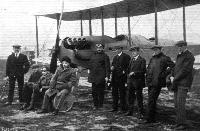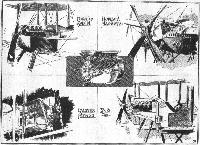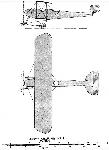C.Barnes Bristol Aircraft since 1910 (Putnam)
The Bristol-Coanda Two-seat Biplanes
When the flying of monoplanes by pilots of the Military Wing, Royal Flying Corps, was banned in September 1912, the loss of the potential War Office market for the Coanda monoplane was partly mitigated by the award of a contract to build the officially designed B.E.2 biplane, which, although ineligible for the Military Aeroplane Competition, had performed rather better than the actual prizewinners. The fact that a biplane could match the monoplane's performance without sacrificing its advantages of strength and stiffness led Coanda to draft a Bristol biplane design, and by November enquiries for a long-range two-seater had come from both Spain and Germany. Coanda preferred the well-tried 80 h.p. Gnome engine, but the enquirers insisted on engines already in use in their own fleets; consequently the Spanish specified the 70 h.p. Renault because it was standardised for their Maurice Farmans, while the Deutsche Bristol-Werke were under government pressure to use the 90 h.p. Daimler-Mercedes. In November 1912, therefore, Coanda began the design of a two-seater biplane suitable for either the Renault or the Daimler-Mercedes. Early in 1913 a Spanish purchasing mission, led by Col. Pedro Vives-y-Vych, visited Filton and Larkhill, and five Renault-engined biplanes were ordered. Designated B.R.70 (later shortened to B.R.7) these were built alongside the first four B.E.2's, and the first B.R.7, No. 157, was finished in time to be shown at Olympia in February 1913, together with Coanda monoplane No. 153. No. 157 was flown at Larkhill in March, but was overloaded with wings of the normal section used on monoplanes. A more cambered profile had been specified for the Daimler-engined biplane, which was being built at Halberstadt, and a set of wings of this shape was tried out on the B.R.7 in April with better results, but still not good enough to meet the contract, so the Spanish government declined to accept delivery. Only seven B.R.7's were built and the second one, No. 158, was tried out with a four-bladed airscrew, without improvement, and a special two-blader with very pointed tips was also made to Coanda's design. On 26 May 1913, Pizey, with his mechanic Fellows as passenger, was flying No. 158 when the carburettor caught fire. He was able to land promptly and both occupants jumped out immediately after touching down, but the B.R.7 was totally destroyed in a few minutes. After this No. 157 remained at Larkhill as an advanced trainer, but the rest of the batch, Nos. 160-163, were rarely flown, although No. 163 was tested with a plain two-wheeled Vee landing gear. A final B.R.7, No. 178, was built in December 1913 with increased span, but never left Filton works.
In Germany, the Daimler-engined biplane underwent considerable modification and finally emerged with extended upper wings having large inversely tapered ailerons, also a supplementary rudder below the stern which nearly doubled the vertical surface area of the tail. This was test-flown by Henri Jullerot in July and August during his term as instructor-in-charge at the Halberstadt school.
Model B.R.7 Daimler
Power Plant 70 hp 90 hp
Renault Daimler
Span 38 ft 57 ft
Length 27 ft 5 in 27 ft 5 in
Wing Area 440 sq ft 570 sq ft
Empty Weight 946 lb 1200 lb
All-up Weight 1826 lb 2100 lb
Speed 63 mph 65 mph
Duration 5 hours 5 hours
Accommodation 2 2
Production 7 1
Sequence Nos. 157, 158 (1 in
160-163 Germany)
178
H.King Armament of British Aircraft (Putnam)
Bristol-Coanda Biplanes. Of such exceptional interest and significance were the bomb and bombsight installations, developed for the Bristol-Coanda biplane exhibited in the Paris Salon of December 1913, that they will be described at length in Volume 2 as historic departures. Original Coanda drawings will be reproduced, together with a page of calculations which influenced the design of the sight. It must be recorded here that an aircraft of similar type, but having a simple bomb-carrier, was delivered to Rumania a few weeks before the show mentioned, and that even earlier yet another Bristol-Coanda biplane was photographed at Larkhill with a mechanic holding a bomb. One RNAS machine of the type was apparently a 'gun-carrier'.
M.Goodall, A.Tagg British Aircraft before the Great War (Schiffer)
Deleted by request of (c)Schiffer Publishing
BRISTOL COANDA Type BR.7 and Daimler biplanes
This long-range, two-seater biplane was designed as a result of interest by Spain and Germany, and was first seen at Olympia in February 1913. There was a divergence of requirements, for the Spanish type had a Renault engine, whilst a Daimler was specified by Germany. Only one of the latter machines was eventually built at Halberstadt by the German Bristol works. This had extended wings, tapered ailerons and an extra rudder below the tail.
At Bristol seven BR.7's were built, of which five for the Spanish government were not accepted. The prototype, Works No. 157, flew in March 1913, but was kept at Larkhill as an advanced trainer. Works No. 158 was destroyed after a fire in the air, Nos.160, 163 were rarely used. A vee type undercarriage was tested on No. 163 and the final machine, No. 178, was built with increased span, but remained at Filton.
Power:
70hp Renault vee eight-cylinder air-cooled
90hp Daimler vee eight-cylinder water-cooled
Data 70hp Renault
Span 38ft
Area 440 sq ft
Length 27ft
Weight 946 lb
Weight allup 1,826lb
Speed 63 mph
Endurance 5hr
Seven aircraft built. Works Nos.157-158, 160-163 & 178.
Data 90hp Daimler
Span 57ft
Area 570 sq ft
Length 27ft 5in
Weight 1,200lb
Weight allup 2,100lb
Speed 65 mph
Endurance 5hr
One aircraft built at Deutsche-Bristol Werke, Halberstadt, Germany
P.Lewis British Aircraft 1809-1914 (Putnam)
Bristol B.R.7
In view of the opposition to the monoplane by the Royal Flying Corps, the British and Colonial Aeroplane Company was reluctantly compelled to concentrate its production on biplanes.
Some six months after the monoplane ban, the B.R.7 Biplane appeared and was displayed at the 1913 Olympia Aero Show. Basically, it consisted of the Coanda Military Monoplane's fuselage, undercarriage and tail unit, which had been fitted with two-bay unstaggered biplane wings. A refinement on the undercarriage was the installation of wheel brakes. Warping was used for lateral control, and the eight-cylinder vee Renault engine of 70 h.p. was fully enclosed apart from cooling vents at the front and sides. This engine was chosen at the request of the Spanish Government, who already used it in their Maurice Farman Biplanes, but, in the final event, the B.R.7 was not sold to Spain but remained at the Company's flying-school at Larkhill, seven being constructed with works numbers 157, 158, 160, 161, 162, 163 and 178.
SPECIFICATION
Description. Two-seat tractor training biplane. Wooden structure, fabric covered.
Manufacturers: The British and Colonial Aeroplane Co. Ltd., Filton, Bristol.
Power Plant: 70 h.p. Renault.
Dimensions: Span, 38 ft. Length, 27 ft. 5 ins. Wing area, 440 sq. ft. Weights: Empty, 946 lb. Loaded, 1,826 lb.
Performance: Maximum speed, 63 m.p.h. Landing speed, 33 m.p.h. Climb, 1,000 ft. in 4 mins.
Price: ?1,800.
Журнал Flight
Flight, February 8, 1913.
WHAT THERE WILL BE TO SEE AT OLYMPIA.
THE MACHINES.
The British and Colonial Aeroplane Co., Ltd.
<...>
The 70-h.p. Renault-engined tractor biplane that the Bristol firm will be showing will be of a new type. Designed by the firm's well-known engineer, Mr. Henri Coanda, who also prepared the drawings of the monoplane we have just briefly described, this biplane will have many features in common with that machine. Thus, its fuselage will be practically identical with that of the monoplane, its landing gear will be of similar design, and the same method of wing construction will be noticeable in the assembly of its planes. The motor, mounted in front, will be almost entirely covered in by an aluminium shield, and will drive a two-bladed Bristol propeller 2.6 metres in diameter. The control will be the same as that employed on the monoplane, the elevator and wing warping being operated by a vertical wheel mounted on an inverted U-shaped bridge. The dimensions of this biplane will be: overall length, 27.5 ft.; span, 38 ft.; chord, 6 ft.; area, 440 sq. ft.; weight, light, 946 lbs.; total useful load, 880 lbs.; speed, 62.5 m.p.h.
 |
P.Lewis - British Aircraft 1809-1914 /Putnam/
|
| Bristol Coanda B.R.7 at 1913 Olympia Aero Show.
|
 |
M.Goodall, A.Tagg - British Aircraft before the Great War /Schiffer/
|
| Bristol Coanda Type BR7 of 1913 for the Spanish government. Works No.157.
|
 |
C.Barnes - Bristol Aircraft since 1910 /Putnam/
|
| Pixton flying B.R.7 No. 157 at Larkhill, 1913.
|
 |
Журнал - Flight за 1913 г.
|
| AT OLYMPIA SHOW. - The 70.h.p. Bristol biplane, as seen from the side.
|
 |
Журнал - Flight за 1913 г.
|
| The new 70-h.p. Bristol biplane, one of the features of the Olympia Show.
|
 |
Журнал - Flight за 1913 г.
|
| Lieut. Roger Marshall, R.F.A. (Reserve), another pupil who passed his brevet tests at the Bristol, Lark Hill, School, in a 15-m.p.h. wind.
|
 |
Журнал - Flight за 1913 г.
|
| A school group at the Bristol Flying School, Amesbury, Wilts., showing just a few pupils grouped round one of the two-seater biplanes. Reading from left to right: Mr. Jullerot, pilot; Mr. David Tod, pupil, who is flying the monoplane excellently; Lieut. Marshall, pupil; Lieut. Chidson, pupil; Mr. C. H. Platon; Herr Paschen, a pilot of the German Bristol School; Mr. Fellows, of the Bristol Co.; Mr. Harrison, pilot; and Lieut Bromet, R.N., pupil.
|
 |
Журнал - Flight за 1913 г.
|
| The 70-h.p. Renault-Bristol biplane.
|
 |
C.Barnes - Bristol Aircraft since 1910 /Putnam/
|
|
|
 |
Журнал - Flight за 1913 г.
|
|
|
 |
Журнал - Flight за 1916 г.
|
| Mounting and housing of Vee-type air-cooled engines. Inset in centre, the Renault engine, showing tubular bearers.
|
 |
P.Lewis - British Aircraft 1809-1914 /Putnam/
|
| Bristol B.R.7
|
 |
Jane's All The World Aircraft 1913 /Jane's/
|
| 70 h.p. biplane.
|














